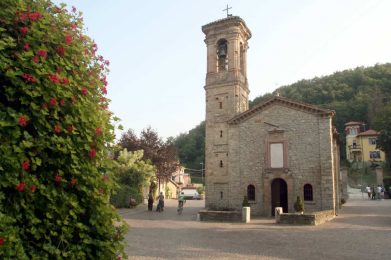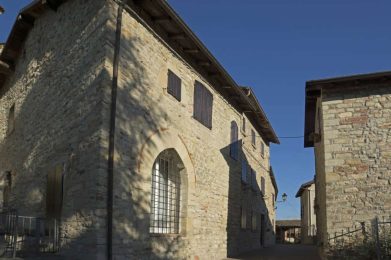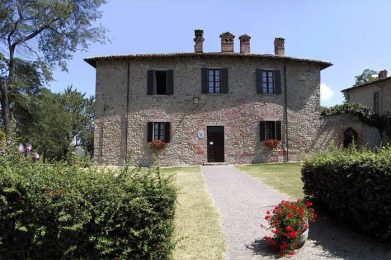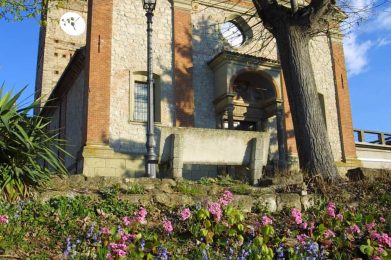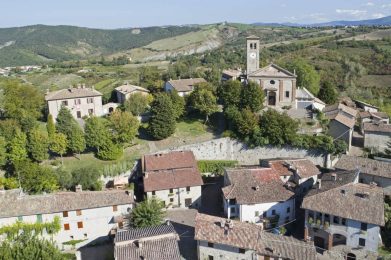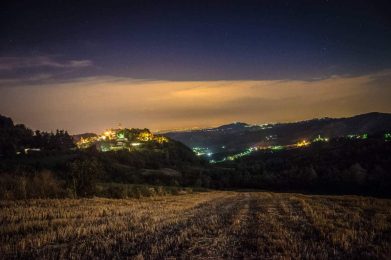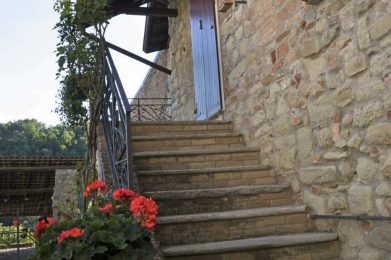Nestled in the greenery of Oltrepò Pavese, Fortunago is one of Italy’s Most Beautiful Villages. With its stone houses, hilly views and traditional cuisine, it offers an authentic and timeless experience.
Immagini del borgo
Nestled in the green heart of the Oltrepò Pavese region, among rolling hills and centuries-old woods, Fortunago is a village that enchants and surprises at every turn. Surrounded by downy oaks, chestnut trees and wild flora that lights up with colors and scents in spring, this small village represents an admirable balance between tradition and modernity.
A village that tells the tale of time
To stroll through Fortunago’s cobblestone streets is to take a plunge into the past: the exposed stone houses, natural wood windows and doors, porphyry lanes and warm, soft lighting transport visitors to an atmosphere that seems suspended, far from the din of modernity. The wooden benches and extreme care of public greenery testify to an attention to detail that makes Fortunago an example of how to enhance a village without distorting its soul.
Views, history and flavors
The landscape offers unique emotions: from the highest point of the village, the view opens out over the hills to Montalto Pavese Castle, while the wheat fields are tinged with yellow and dotted with the blue of cornflowers. In spring, the woods explode in a symphony of primroses, daffodils and periwinkles, while birds and insects enliven the vineyards and orchards, symbols of an area that lives in harmony with nature.
Fortunago is also famous for its gastronomic excellence: Malfatti, poor gnocchi made with stale bread, herbs and eggs, seasoned with butter and sage or meat sauce, are a traditional dish recognized with the De.Co. mark for its typicality and deep connection with the territory. A must for those who want to savor the authentic cuisine of the Oltrepò.
Artistic and architectural treasures
The village holds precious testimonies of the past: the Church of San Giorgio, dating back to 1609, preserves a tempera-on-wood triptych attributed to Pesina and a fascinating Annunciation fresco on the portal lunette. Near the church are the remains of the medieval castle, with a 15th-century rectangular tower and stretches of wall that tell stories of ancient lordships.
The lower part of the village surprises with the very old church of St. Anthony, or Oratory, built of stone and brick, still used for daily celebrations. And for a singular refreshment, the San Ponzo fountain offers natural and sparkling water, a curious detail that makes the experience in Fortunago even more unique.
A thousand-year history
Fortunago’s origins go back in time: the toponym, with the suffix “-aco,” suggests Celtic roots and a connection to water, reinforced by the existence of a mineral spring. Documents from the 10th century attest to the Latin form Fortunacum and its belonging to the committee of Tortona. Over the centuries, the village came under the rule of illustrious families: the Dal Verme, the Malaspina di Oramala, and from 1743 it entered the Kingdom of Sardinia with the Province of Bobbio.
Protected nature and biodiversity
The upper part of the village lies on a plateau about 600 meters above sea level, an area now protected for its priceless natural heritage: broadleaf forests such as farnia, maple, manna ash, wild cherry, and hornbeam, as well as anemones, orchids, lilies of the valley, cyclamens, and many medicinal species. Wildlife is equally rich: birds of prey, protected avifauna, titmice, blackcaps, nightingales, white-winged dancers, as well as deer and roe deer that populate the woods, making Fortunago a paradise for nature lovers.
Enhancement and recognition
Fortunago has been completely restored respecting traditional architecture, becoming a virtuous example of the recovery of historical heritage and landscape. It is one of Italy’s Most Beautiful Villages, and its authentic beauty was the backdrop for scenes in Paolo Virzì’s film Il Capitale Umano. In 2015, it also won a Guinness World Record for the world’s heaviest agnolotto, weighing an impressive 148 kg, a symbol of an unbreakable bond with culinary tradition.
A unique experience
Getting lost in the narrow streets of Fortunago, being enveloped by its quietness and savoring the slowness that characterizes it is an experience that regenerates the spirit. Whether it is for an excursion, a romantic weekend, a food and wine tour or a simple moment of respite, this village will captivate every visitor with its timeless poetry, genuine flavors and a landscape that remains in the heart.
Village of Fortunago
Municipality of Fortunago
Province of Pavia
Region Lombardia
Inhabitants: 383 fortunaghesi
Altitude center: 482 m a.s.l.
The Municipality is part of:
I Borghi più belli d’Italia
Municipality
Piazza Aldo Moro 1 – Tel. 0383-875213
BY CAR
- From Milan: Take the A7 highway, exit at Casei Gerola, continue towards Casei, take the SP 206, continue on the Tangenziale di Voghera towards Casteggio / Piacenza, pass Voghera, continue on the SS 10, continue towards Torrazza Coste, pass the hamlets of Schizzola, Arpesina, continue towards Fortunago.
- From Bologna: From the A14 highway continue on the A1 highway, follow the direction to Piacenza, near Piacenza continue on the A21 highway, exit at Casteggio / Casatisma, take the SS 35 towards Casteggio / Voghera, near Montebello della Battaglia, continue on the SS 10, pass the town of Casteggio, continue on the SP 203 and follow the indications for Fortunago.
- From Genoa: From the A7 highway, follow the direction to Piacenza, continue on the A21 highway, exit at Voghera, take the Tangenziale di Voghera, pass Voghera, continue on the SS 10, continue towards Torrazza Coste, take the SP 138 and follow the indications for Fortunago.
- From La Spezia: From the A15 highway, follow the direction of Milan, continue on the A1 del Sole highway, follow the direction for Piacenza, near Piacenza continue on the A21 highway, exit at Casteggio / Casatisma, take the SS 35 towards di Casteggio / Voghera, take the Tangenziale di Casteggio, near Montebello della Battaglia, continue on the SS 10, pass the town of Casteggio, continue on the SP 203 and follow the signs for Fortunago.
- From Brescia: Take the A21 motorway in the direction of Turin, exit at Casteggio / Casatisma, take the SS 35 in the direction of Casteggio / Voghera, take the Tangenziale di Casteggio, near Montebello della Battaglia, continue on the SS 10, pass the town of Casteggio, continue on the SP 203 and follow the signs for Fortunago.
- From Pavia: Take the SS 35, pass Borgo Ticino, take the Casteggio ring road, near Montebello della Battaglia, continue on the SS 10, pass the town of Casteggio, continue on the SP 203 and follow the directions for Fortunago.
BY PLANE
- Milan Linate Airport
- Genoa airport
- Milan Malpensa Airport
- Bergamo airport
- Parma airport
BY SEA
- Port of Genoa

